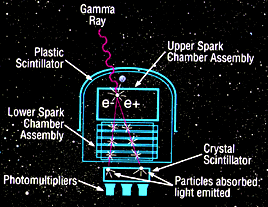How do scientists see gamma rays? - Introduction
How do scientists "see" gamma rays?

Cosmic gamma rays
are difficult to detect for at least two reasons: (1) there are not many
of them compared to other things that "look" like cosmic gamma rays
to a detector, but aren't; and (2) they have so much energy that it is hard to
"capture" one at all!
The noise or background against which a "real" cosmic gamma ray must be seen is about 1000 times stronger or brighter or more intense than the gamma ray the scientist is looking for. This makes it very hard to pick out "what is real and what isn't". The primary source of the noise is cosmic rays. These energetic particles interact with stuff in the Earth's atmosphere and with the satellite materials to produce "noise", or unwanted, non-cosmic, gamma rays in the detector. Figuring out how to separate the real photons from the noise photons is quite a chore for a high-energy astronomer.
Since gamma rays cannot be focused by conventional telescope techniques, i.e. lenses and mirrors, the challenge of gamma-ray astronomers is to capture individual gamma-ray photons however they can, and gather as much information as possible from each one. Gamma-ray photons have so much energy that they like to pass right through most materials without interacting with them -- so you wouldn't even know that the gamma ray had been there! How, then, do we 'detect' gamma rays? We pick certain special kinds of materials that the gamma-ray photon WILL interact with, resulting in a spark or a glow that can be analyzed by scientists. Devices called spark chambers and scintillation detectors are used to record the passage, arrival time, trajectory, and energy of the gamma ray.

